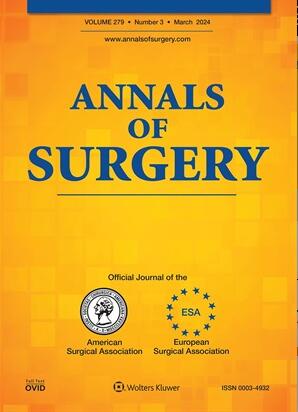Assessment of the NIH Salary Cap Gap Reveals the Increasing Financial Burden of Training and Hiring Surgeon-Scientists.
IF 6.4
1区 医学
Q1 SURGERY
引用次数: 0
Abstract
OBJECTIVE The goal of this study was to evaluate trends in the cost-share required to support NIH funded surgeon trainees and faculty. SUMMARY OF BACKGROUND DATA Surgeon-scientists are critical to advancing our understanding of surgical diseases and innovating care of surgical patients. However, demands for clinical productivity while securing extramural funding in the setting of increasingly competitive National Institutes of Health (NIH) funding paylines has limited growth of the surgeon-scientist workforce. METHODS The NIH salary cap and postdoctoral fellow stipends were obtained from the NIH website. The median total compensation for faculty at the Associate Professor rank (Non-Clinical, Clinical Faculty, Surgeons, and Surgical Subspecialties) and PGY3 level residents were obtained from Association of American Medical College data. Data were analyzed for fiscal years 2001-2023 (faculty) and 2005-2003 (trainees). Changes in the salary cap gap over time were forecasted using an exponential smoothing algorithm. RESULTS Over the study period, no cost-share was required for non-clinical faculty, while the cost-share for a surgeon investigator increased from $18,360 to $68,660 per year. For a single postdoctoral fellow trainee, the cost-share increased from $22,932 to $31,608 annually. In 2023, the total cost-share to support the program director and four positions on a T32 training grant was estimated to be $250,631. The cost-share for surgeon investigators is projected to expand by another 47% by 2035. CONCLUSIONS This analysis demonstrates that the NIH salary cap gap creates a financial challenge for institutions and Departments of Surgery, which is projected to increase substantially over the next decade. These data highlight the urgency to advocate for policy development to adequately compensate federally funded surgical investigators and should facilitate dialogue within institutions to develop alternative funding mechanisms for surgeon-scientists.美国国立卫生研究院工资上限差距的评估揭示了培训和雇用外科医生科学家的经济负担日益增加。
目的本研究的目的是评估支持NIH资助的外科实习生和教师所需的费用分担趋势。数据科学家对提高我们对外科疾病的理解和创新外科患者的护理至关重要。然而,在竞争日益激烈的美国国立卫生研究院(NIH)资助薪酬线的背景下,对临床生产力的需求,同时确保校外资金,限制了外科科学家劳动力的增长。方法从NIH网站获取NIH的工资上限和博士后津贴。副教授(非临床、临床、外科和外科亚专科)和PGY3级住院医师的总薪酬中位数来自美国医学院协会的数据。分析了2001-2023财政年度(教师)和2005-2003财政年度(学员)的数据。使用指数平滑算法预测工资帽差距随时间的变化。结果在研究期间,非临床教师不需要分担费用,而外科医生调查员的费用分担从每年18,360美元增加到68,660美元。对于一名博士后实习生来说,每年的费用分担额从22,932美元增加到31,608美元。在2023年,支持项目主任和T32培训补助金的四个职位的总费用分摊额估计为250,631美元。预计到2035年,外科医生调查员的费用份额将再扩大47%。本分析表明,NIH的工资上限差距给机构和外科部门带来了财政挑战,预计在未来十年将大幅增加。这些数据强调了倡导政策发展的紧迫性,以充分补偿联邦资助的外科研究人员,并应促进机构内的对话,为外科科学家制定替代的资助机制。
本文章由计算机程序翻译,如有差异,请以英文原文为准。
求助全文
约1分钟内获得全文
求助全文
来源期刊

Annals of surgery
医学-外科
CiteScore
14.40
自引率
4.40%
发文量
687
审稿时长
4 months
期刊介绍:
The Annals of Surgery is a renowned surgery journal, recognized globally for its extensive scholarly references. It serves as a valuable resource for the international medical community by disseminating knowledge regarding important developments in surgical science and practice. Surgeons regularly turn to the Annals of Surgery to stay updated on innovative practices and techniques. The journal also offers special editorial features such as "Advances in Surgical Technique," offering timely coverage of ongoing clinical issues. Additionally, the journal publishes monthly review articles that address the latest concerns in surgical practice.
 求助内容:
求助内容: 应助结果提醒方式:
应助结果提醒方式:


